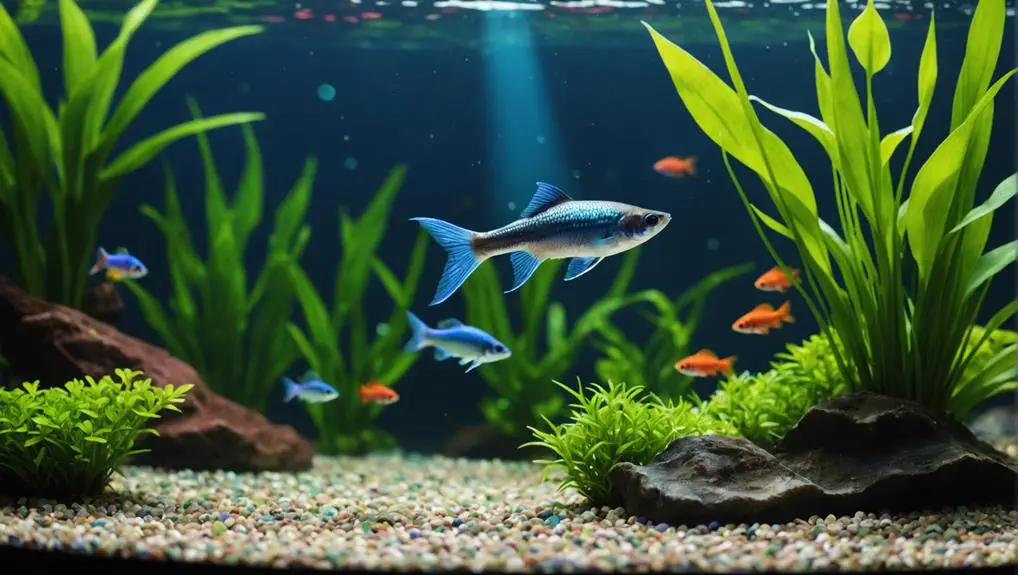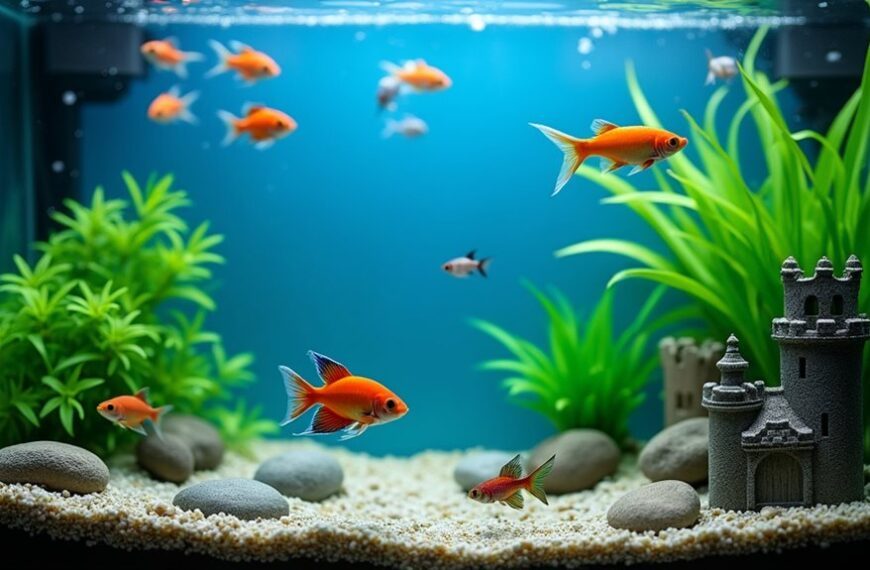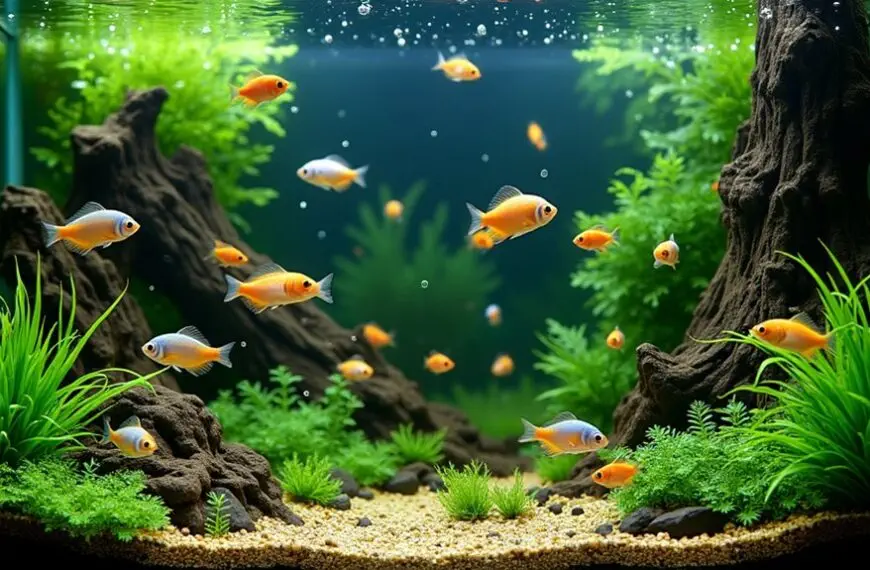Choosing low-maintenance fish is a fantastic idea for beginners like you! These easy-care buddies make it simple to jump into the aquarium hobby without drowning in stress. Fish like guppies and bettas thrive in smaller tanks, too, and they tolerate a range of water conditions. Plus, they're pretty peaceful, creating a nice community vibe. With water changes every 2-4 weeks and minimal feeding, you'll save time for the fun stuff—like watching them wiggle around! Best of all, low-maintenance fish help you avoid the overwhelming side of fishkeeping. Stick around, and you'll discover even more tips to make your first aquarium a success!
Contents
Benefits of Low-Maintenance Fish
One of the biggest perks of keeping low-maintenance fish is how easy they're to care for. If you're a beginner or just someone with a busy life, these hardy fish require simple routines that won't take up all your time.
Many low-maintenance species, like guppies and neon tetras, are resilient and can tolerate various water conditions, which aligns well with the importance of water quality management. This means less stress for you and your fish!
You'll find that fish like Betta and Cory Catfish are known for their peaceful nature, making them perfect for community tanks. They thrive together, creating a harmonious atmosphere that's lovely to watch.
With regular water changes every 2-4 weeks, maintaining optimal water quality is a breeze. That's right; you won't need to spend your weekends scrubbing tanks!
Additionally, low-maintenance fish often do well in smaller tanks of 10 gallons or more. This not only makes tank setup easier but also allows you to create an engaging environment without feeling overwhelmed.
Ideal Fish Species for Beginners
When selecting fish species for your first aquarium, it's essential to choose those that aren't only beautiful but also easy to care for.
Goldfish are a classic choice; they're resilient and can grow quite large, so remember a minimum of 20 gallons per fish is necessary. Additionally, maintaining proper water parameters, like a stable pH and temperature, is crucial for their health and longevity proper water parameters.
If you're drawn to vibrant colors, Betta fish are perfect. They thrive in tanks of at least 5 gallons and love warm waters.
For a community tank, Guppies are fantastic small fish that adapt well and enjoy being in groups.
Neon Tetras are another great option—these peaceful schooling fish add a splash of color and require minimal care. You'll want to keep them in groups of 3-5, though.
Lastly, consider Cory Catfish. These friendly bottom dwellers not only help keep your tank clean by scavenging but also enjoy the company of their own kind, so aim for at least five.
Choosing these beginner fish will make your aquarium journey enjoyable and rewarding.
Your new aquatic friends will surely bring joy to your home while being easy to care for. Happy fish-keeping!
Essential Care Requirements

Choosing the right fish is just the beginning; understanding their care requirements is key to keeping them healthy and thriving.
First off, low-maintenance fish like guppies and neon tetras love a tank size of at least 10 gallons. This makes your life easier since they need water changes only every 2-4 weeks. Maintaining clean, balanced water is crucial for their health, ensuring optimal conditions for growth and vitality. Talk about a win!
Feeding these beginner-friendly species is simple too. A diet of high-quality flakes or pellets mixed with some occasional live or frozen treats will keep them happy and healthy. Plus, many of these adaptive fish can handle pH levels from 6.0 to 8.0, so you won't need to stress over perfect water conditions.
Routine tank maintenance is a breeze with these fish, as they typically produce less waste. That means less time vacuuming gravel and more time enjoying their company!
Easygoing community fish, like Harlequin rasboras and platies, make it even more enjoyable, fostering a peaceful aquarium environment. With all these aspects in mind, you'll find that caring for low-maintenance fish can be a rewarding experience, allowing you to focus on the joy of having a vibrant aquatic world!
Setting Up Your Aquarium
Setting up your aquarium might feel a bit overwhelming at first, but don't worry, it can be a fun adventure!
You'll want to gather some essential equipment, pick the right fish, and create optimal water conditions to ensure a happy, healthy home for your aquatic buddies.
Essential Equipment Requirements
Creating a thriving aquarium requires the right equipment to ensure your fish have a safe and comfortable environment.
Start with a tank that's at least 10 gallons; this gives your fish plenty of space to swim and helps stabilize water conditions. A quality filter is essential for keeping the water clear and healthy. If you're thinking about tropical fish, don't forget a heater! Set it between 72-82°F for a cozy aquatic environment.
Next, consider your substrate. A soft substrate is perfect for bottom-dwellers like Cory Catfish, making their foraging adventures enjoyable. Regular water test kits are a must, too; they help you monitor pH, ammonia, and nitrate levels, ensuring your fish thrive.
Lastly, don't skimp on decor and hiding spots. Adding rocks and plants not only beautifies your aquarium but also provides safe spaces for your fish to feel secure and reduce stress.
Just think of it as decorating a cozy home for your aquatic friends! With the right equipment, you'll create a lovely environment that lets you watch your fish flourish and enjoy their little underwater world.
Choosing the Right Fish
Once you've established your aquarium's environment with the right equipment, it's time to think about the fish you'll invite into this new habitat.
Choosing beginner-friendly fish like guppies, cherry barbs, and neon tetras is a fantastic way to start. These species thrive in a community aquarium and require minimal care. A tank size of at least 10 gallons is essential, giving your fish enough space to swim and reducing stress levels.
To create a healthy environment, make sure your tank is well-filtered and heated. This helps maintain stable conditions that cater to your fish's needs.
Regular maintenance is key, so plan to perform water changes every 2-4 weeks. It's a small task that goes a long way in keeping your fish happy and healthy.
Don't forget to add decorations and plants! They provide hiding spots and visual interest while encouraging natural behaviors among your fish.
Think of it as setting up a cozy home for them. With a little love and care, your low-maintenance fish will thrive, making your aquarium a delightful centerpiece in your home.
Optimal Water Conditions
Maintaining optimal water conditions is crucial for the health of your fish and the overall success of your aquarium. Think of your tank as a cozy home for your low-maintenance fish, like neon tetras. They thrive best when you keep a close eye on a few key elements:
- pH level: Aim for a balanced pH suited to your fish. Guppies like it between 6.5 and 8.0, while cherry barbs prefer 6.0 to 7.0.
- Water temperature: Keep it between 72 to 82°F for a comfortable habitat.
- Regular water changes: Change about 10-20% of the water every 2-4 weeks to keep toxin levels low.
Before you add your fish, cycle your aquarium to establish beneficial bacteria. This bacteria will help convert toxic ammonia from fish waste into safer substances.
Regularly testing water parameters like ammonia and nitrate is key to preventing disease outbreaks. Remember, a happy aquarium ecosystem means happy fish!
Maintaining Water Quality

Keeping your fish healthy hinges on maintaining optimal water quality. To do this, you'll want to conduct regular testing of your aquarium's water, checking levels of pH, ammonia, and nitrates at least every two weeks. Think of it as a routine check-up for your aquatic friends!
Another essential task is performing water changes—about 15-25% every 2-4 weeks. This helps reduce waste and keeps the environment stable for your fish. Just remember to use dechlorinated water, as chlorine and chloramines in tap water can harm your finned companions. A good water conditioner will save the day!
If you're keeping tropical fish, a heater is your best friend, keeping the water temperature in the sweet spot (like 72-82°F for Cory Catfish).
Don't forget a quality filter, too! It ensures proper water circulation and biological filtration, promoting a clean and healthy tank.
Observing Fish Behavior
Observing your fish is more than just a pastime; it's a window into their world and well-being.
By watching their swimming patterns and interactions, you can spot any signs of stress or discomfort, which is key to keeping them happy.
Plus, who doesn't enjoy a little fish drama when the neon tetras start showing off their moves?
Importance of Observation
Awareness of your fish's behavior is vital for fostering a thriving aquarium. By regularly observing your aquatic pets, you can detect signs of stress, illness, or aggression, ensuring a healthy aquarium environment.
Understanding fish behavior isn't just fascinating; it also helps you make informed decisions!
Here are three key aspects to pay attention to:
- Schooling and Group Dynamics: Knowing which fish prefer to school can guide your compatible choices in community tanks.
- Feeding Habits: Observing your fish during feeding times helps you tailor their diets, preventing overfeeding and ensuring they get the nutrients they need.
- Breeding Behavior: Keeping an eye on breeding can help you manage populations and avoid overstocking.
Recognizing Stress Signals
Stress signals in fish can be subtle yet crucial for maintaining a healthy aquarium. You might notice your fish hiding frequently or remaining stationary, which could indicate they're feeling threatened or unsafe.
If they're gasping at the surface or swimming erratically, it's a sign of oxygen deprivation or water quality issues—time for immediate action!
Watch for aggressive behaviors, too. Fin nipping or chasing can stem from territorial disputes, often made worse by overcrowding or incompatible tank mates.
If your fish suddenly lose their appetite or seem uninterested in food, it could signal stress, illness, or environmental incompatibility. This is a good moment to reevaluate your tank conditions or consider if your fish are truly compatible.
Also, keep an eye on your fish rubbing against decorations; that could indicate parasitic irritation. In such cases, a health assessment is essential to ensure their well-being.
Remember, a happy fish makes for a happy aquarium! By recognizing these stress signals, you can create a thriving environment for your aquatic friends.
After all, they rely on you to keep their underwater world just right. Happy fishkeeping!
Frequently Asked Questions
What Is the Easiest Fish to Take Care of for Beginners?
For beginners, consider guppies or neon tetras in a community tank. They're easy to care for, adapt well, and require simple maintenance tips, like monitoring water parameters and feeding frequency to ensure fish compatibility and health.
What Fish Is the Best for Beginners?
When choosing fish for beginners, consider guppies for community tanks, neon tetras for vibrant schools, and Cory catfish for substrate cleaning. Each offers easy aquarium setup, fish compatibility, and manageable feeding schedules, ensuring a rewarding experience.
What Fish Requires the Least Maintenance?
When considering fish that require the least maintenance, you'll find betta fish and guppies essential. Their simple feeding schedules, adaptability to various water parameters, and resistance to fish diseases make them perfect for your aquarium plants and shrimp tank.
What Is the Best Fish for First Time Eaters?
You'd think fish preparation isn't complex, but it can dazzle your guests. Popular species like salmon and tilapia offer rich flavor profiles. Consider sustainable sourcing and regional varieties for health benefits and culinary traditions in your serving suggestions.
Final Thoughts
Choosing low-maintenance fish is like finding a trusty sidekick in your aquarium adventure. They make it easy to enjoy the beauty of fishkeeping without drowning in responsibilities. With the right species, simple care, and a little attention to water quality, you'll be swimming in success in no time. So, dive in, embrace the joy of watching your fish flourish, and remember—sometimes, less really is more in this underwater world! Happy fishkeeping!












